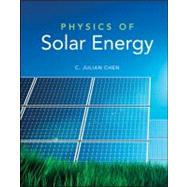
Note: Supplemental materials are not guaranteed with Rental or Used book purchases.
Purchase Benefits
What is included with this book?
List of Figures xix
List of Tables xxv
Chapter 1: Introduction 1
1.1 Solar Energy 1
1.2 Go beyond Petroleum 5
1.3 Other Renewable Energy Resources 8
1.4 Solar Photovoltaics Primer 22
1.5 Above Physics 26
Problems 40
Chapter 2: Nature of Solar Radiation 41
2.1 Light as Electromagnetic Waves 41
2.2 Optics of Thin Films 47
2.3 Blackbody Radiation 52
2.4 Photoelectric Effect and Concept of Photons 58
2.5 Einstein・s Derivation of Blackbody Formula 63
Problems 65
Chapter 3: Origin of Solar Energy 67
3.1 Basic Parameters of the Sun 68
3.2 Kelvin・Helmholtz Time Scale 70
3.3 Energy Source of the Sun 72
Problems 74
Chapter 4: Tracking Sunlight 77
4.1 Rotation of Earth: Latitude and Longitude 77
4.2 Celestial Sphere 78
4.3 Treatment in Solar Time 84
4.4 Treatment in Standard Time 95
Problems 103
Chapter 5: Interaction of Sunlight with Earth 105
5.1 Interaction of Radiation with Matter 105
5.2 Interaction of Sunlight with Atmosphere 108
5.3 Penetration of Solar Energy into Earth 114
Problems 117
Chapter 6: Thermodynamics of Solar Energy 119
6.1 Definitions 119
6.2 First Law of Thermodynamics 121
6.3 Second Law of Thermodynamics 123
6.4 Thermodynamic Functions 127
6.5 Ideal Gas 130
6.6 Ground Source Heat Pump and Air Conditioning 133
Problems 142
Chapter 7: Quantum Transitions 143
7.1 Basic Concepts of Quantum Mechanics 143
7.2 Many-Electron Systems 150
7.3 The Golden Rule 154
7.4 Interactions with Photons 159
Problems 160
Chapter 8: pn-Junctions 161
8.1 Semiconductors 161
8.2 Formation of a pn-Junction 166
8.3 Analysis of pn-Junctions 170
Problems 176
Chapter 9: Semiconductor Solar Cells 177
9.1 Basic Concepts 177
9.2 The Shockley・Queisser Limit 183
9.3 Nonradiative Recombination Processes 191
9.4 Antireflection Coatings 194
9.5 Crystalline Silicon Solar Cells 200
9.6 Thin-Film Solar Cells 204
9.7 Tandem Solar Cells 207
Problems 209
Chapter 10: Solar Electrochemistry 211
10.1 Physics of Photosynthesis 211
10.2 Artificial Photosynthesis 219
10.3 Genetically Engineered Algae 219
10.4 Dye-Sensitized Solar Cells 219
10.5 Bilayer Organic Solar Cells 222
Problems 224
Chapter 11: Solar Thermal Energy 225
11.1 Early Solar Thermal Applications 225
11.2 Solar Heat Collectors 228
11.3 Solar Water Heaters 240
11.4 Solar Thermal Power Systems 242
Problems 250
Chapter 12: Energy Storage 253
12.1 Sensible Heat Energy Storage 253
12.2 Phase Transition Thermal Storage 257
12.3 Rechargeable Batteries 262
12.4 Solar Energy and Electric Vehicles 269
Problems 272
Chapter 13: Building with Sunshine 273
13.1 Early Solar Architecture 274
13.2 Building Materials 275
13.3 Example of Holistic Design 280
13.4 Land Usage of Solar Communities 283
Problems 286
Appendix A: Energy Unit Conversion 287
Appendix B: Spherical Trigonometry 289
B.1 Spherical Triangle 289
B.2 Cosine Formula 290
B.3 Sine Formula 291
B.4 Formula C 292
Problems 294
Appendix C: Quantum Mechanics Primer 295
C.1 Harmonic Oscillator 295
C.2 Angular Momentum 297
C.3 Hydrogen Atom 300
Appendix D: Statistics of Particles 303
D.1 Maxwell・Boltzmann Statistics 304
D.2 Fermi・Dirac Statistics 306
Appendix E: AM1.5 Reference Solar Spectrum 307
List of Symbols 313
Bibliography 315
Index 321
The New copy of this book will include any supplemental materials advertised. Please check the title of the book to determine if it should include any access cards, study guides, lab manuals, CDs, etc.
The Used, Rental and eBook copies of this book are not guaranteed to include any supplemental materials. Typically, only the book itself is included. This is true even if the title states it includes any access cards, study guides, lab manuals, CDs, etc.